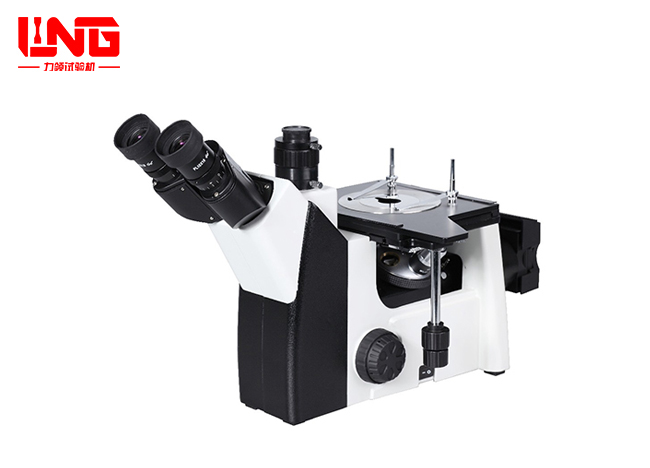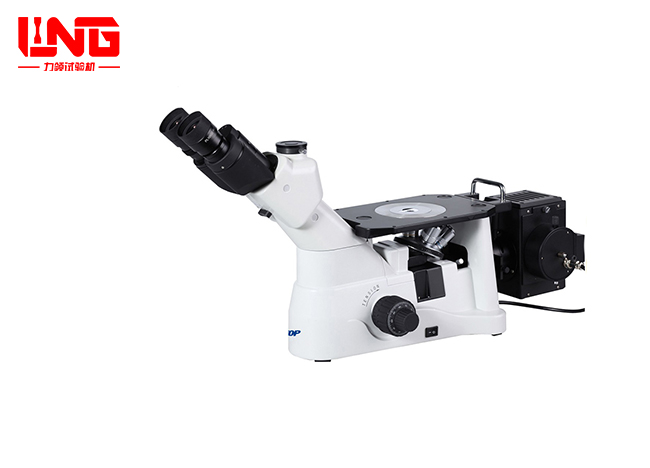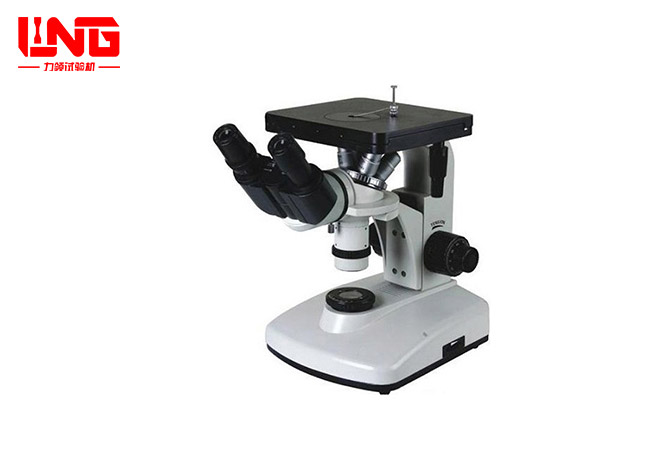- Máquina de prueba de fatiga dinámica
- Máquina de prueba de fricción y desgaste
- Máquina de prueba especial del sujetador
- Máquina de prueba de propiedades mecánicas estáticas
- Máquina de prueba de tracción in situ
- Equipo mecánico grande y pequeño personalizado no estándar
- Equipo de preparación y análisis de muestras metalográficas
- durometro
- Solución de diseño general y planificación del laboratorio
Microscopio metalográfico trinocular invertido
El microscopio metalográfico invertido trinocular se utiliza para identificar y analizar la estructura combinada de varios metales y materiales de aleación. Se utiliza ampliamente en fábricas o laboratorios para identificar la calidad de las fundiciones; inspeccionar las materias primas o analizar la estructura metalográfica de los materiales después del procesamiento; y estudiar algunos fenómenos superficiales como la pulverización superficial. Es un medio eficaz para el análisis metalográfico de acero, materiales de metales no ferrosos, fundiciones y recubrimientos; Análisis petrográfico en geología; e investigación microscópica sobre compuestos, cerámica, etc. en el campo industrial. Es un instrumento para la metalurgia y la ciencia de los materiales para estudiar la estructura organizativa de los materiales, y también es ampliamente utilizado en biología, medicina y enseñanza.
Introducción
Se utiliza para identificar y analizar la estructura combinada de varios metales y materiales de aleación. Se utiliza ampliamente en fábricas o laboratorios para identificar la calidad de las fundiciones; inspeccionar las materias primas o analizar la estructura metalográfica después del procesamiento del material; y estudiar algunos fenómenos superficiales como la pulverización superficial. Es un análisis metalográfico de acero, materiales de metales no ferrosos, fundiciones y recubrimientos; Análisis petrográfico geológico; y un medio de investigación microscópica sobre compuestos, cerámica, etc. en el campo industrial. Es un instrumento para la metalurgia y la ciencia de los materiales para estudiar la estructura organizativa de los materiales. También se utiliza ampliamente en biología, medicina y enseñanza. Cada vez más investigación ya no se satisface con la microscopía metalográfica convencional y la fotografía. La imagen microscópica se introduce en el microordenador, y el microprocesador realiza varios postprocesamientos sobre la imagen. Es una nueva tecnología en el campo de la microscopía en sincronización con el mundo de hoy. El microscopio metalográfico de imagen está conectado a un sistema de cámara CCD de alta definición, y el ordenador procesa, edita, guarda y emite la imagen (como impresión, etc.) o entra en el sistema multimedia y correo electrónico.
Si está conectado adicionalmente al sistema operativo informático de análisis de imagen, también puede estudiar y analizar adicionalmente el espectro metalográfico, o realizar mediciones precisas de la imagen, y análisis de morfología de imagen multifuncional, estadísticas e informes gráficos de salida.
■ Utilice lentes profesionales de objetivos metalográficos y oculares de campo plano, buena calidad de imagen, alta resolución y observación cómoda.
■ Proporcionar una excelente calidad de imagen y una estructura mecánica estable y fiable.
■ Se pueden utilizar accesorios correspondientes de fotografía y vídeo opcionales para recoger y guardar las imágenes observadas, y el análisis de imagen metalográfica se puede realizar con computadoras e imágenes de software de análisis metalográfico profesional.
■ Fácil de operar, accesorios completos, ampliamente utilizados en la enseñanza y la investigación científica análisis metalográfico, detección de obleas de silicio semiconductor, análisis de minerales de dirección, medición de ingeniería de precisión y otros campos.
Parámetros
Parámetros técnicos detallados:
Parámetro
Especificación
Estructura
Trinocular articulado, inclinación 45°, ajuste dióptrico bilateral (±5 dioptrías),
Ampliación
50× – 500×
Objetivo
Objetivo metalográfico plan-acromático de larga distancia de trabajo:
Ocular
Ocular de campo plano y amplio (PL10×/18 mm)
Micrómetro
Valor de escala: 0,01 mm/1 mm
Platina
Plataforma móvil mecánica de tres capas (área 180 × 155 mm),
Mecanismo de enfoque
Coaxial de ajuste grueso/fino con posición baja:
Sistema de iluminación
Iluminación epi-Köhler con:
Sistema óptico
Sistema de corrección de aberración para distancias finitas.
Dispositivo de polarización
Polarizador y analizador extraíbles del trayecto lumínico,
Alimentación eléctrica
220 V CA (50 Hz)
Rango de ajuste de distancia interpupilar: 54–75 mm,
Relación de división de luz fija: binocular/trinocular = 80%:20%.
- 5×, 10×, 20×, 50×
Control de posición baja a mano derecha, recorrido: 75 × 40 mm,
Placa metálica con orificio central Φ12 mm.
- Recorrido grueso por revolución: 38 mm,
- Precisión de ajuste fino: 2 μm,
- Mecanismo de ajuste de tensión.
- Diafragma de apertura variable y campo ajustable central,
- Voltaje adaptable 100–240 V,
- Lámpara LED cálida de 5 W (opcional lámpara halógena 6 V/30 W),
- Intensidad lumínica ajustable continuamente.
Placa de analizador giratoria 360° (opcional).







